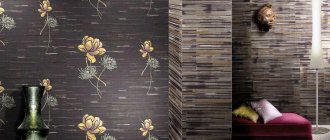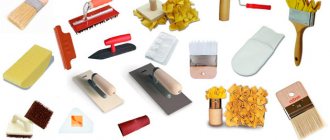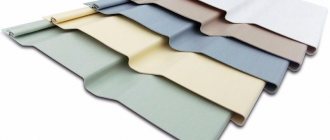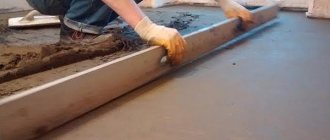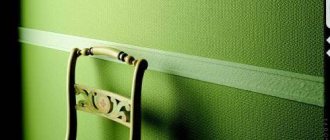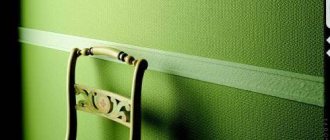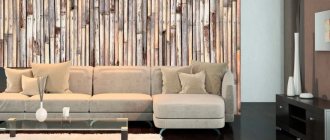Surface Requirements
Unfinished concrete walls have a rough surface that contains depressions and cavities. There is a separate question about the curvature of the walls - if it is significant, it will not be possible to glue paper and other canvases smoothly. The granular structure forms a microrelief, the canvas will bulge, this can lead to pieces of it falling off.
If you stick paper or other wallpaper on “bare” concrete, the following troubles will arise:
- Concrete comes in a variety of shades, but the most common is dark gray. Over time, it will change the color of the pasted wallpaper, not for the better.
- Uneven distribution of glue will cause white spots to appear.
- As the adhesive dries, it forms bubbles near the shells and cracks. This spoils the appearance and also leads to peeling of the decorative layer.
- The joints will not turn out neat, this will affect the choice of wallpaper - their circle will be limited to a simple pattern.
Before gluing any material to a concrete wall, you will have to do minimal preparation. Its complexity depends on the type of material:
- Expanded clay concrete blocks usually require putty, and in advanced cases - plaster.
- Monolithic reinforced concrete blocks have a slightly smoother surface; here you can only get by with putty.
- Foam-, gas-concrete is similar in surface to the previous variety.
- Large-panel houses have the smoothest surface, but for thin wallpaper you will have to apply a layer of putty.
Particular attention should be paid to the corners - this is where canvases on curved walls are most likely to come off. The front of the preparatory work is individual in each case, the main thing is to get the result in the form of a flat surface without cavities and cracks.
Important! Reinforcement is often “hidden” in hardened cement; its interaction with wallpaper, even through concrete, ends in failure: rust stains appear on the decorative layer.
Is it possible to glue paper and liquid wallpaper?
You can stick both paper and liquid ones, the main thing is to properly prepare the base . Although a concrete wall may seem smooth at first glance, if you look closely, you will see small cracks, sinkholes and damage that need to be removed.
Many people believe that liquid wallpaper hides cracks and unevenness; this is not true; if the light falls at an angle, all the flaws become visible.
There are craftsmen who do not always prepare walls for wallpapering, but most experts insist that before carrying out this work, it is imperative to prepare any surface .
If we talk about the need to prepare a concrete wall for wallpapering, the arguments will be as follows:
- Often the wall has a curvature that can be corrected during preparation for wallpapering. If you do not do this, you will not be able to glue and join the strips evenly, and you will end up with gaps or overlaps.
- The concrete surface has a grainy structure and if it is not prepared, it will appear through the wallpaper in the form of bubbles and depressions, which does not decorate the wall in any way.
- The color of concrete slabs can range from bright gray to dark gray, and therefore the color of the wallpaper will change, which is especially noticeable when using light shades. In addition, in different areas, the color of the concrete may differ, and the wallpaper will become spotted.
- In concrete slabs, the reinforcement is often close to the surface and over time, rust may appear on the wallpaper; it must be treated with an anti-rust solution and painted.
- The glue in sinkholes and cracks will dry unevenly, causing bubbles to appear and the wallpaper may peel off.
You can glue paper, non-woven, textile, as well as heat-insulating wallpaper onto concrete walls for additional insulation of the wall, but in order for them to look beautiful, it is necessary to properly prepare the surface.
What wallpaper can be glued to concrete without finishing?
Wallpapering without preparation on concrete walls will be successful only if the surface quality is good. As noted above, this material can affect the color of the decorative layer, so choosing light-colored canvases is not recommended (unless the wall itself is white). Preference should be given to dense textures with an “opaque” pattern. Thin paper and metal varieties do not fit well on a porous surface; you will have to use a lot of glue or still plaster the wall.
Basic Rules
Considering the peculiarities of the porous texture of concrete walls, it is not recommended to glue wallpaper on them without first treating the working surface. Neglecting this preparation can lead to the following consequences:
- the relief of an uneven surface can appear through the wallpaper, especially if the rolled materials are light in color;
- the dark color of concrete will be noticeable under thin wallpaper;
- drying of the glue around sinks and microcracks will lead to the formation of bubbles on the surface of the finished finish and to partial peeling of the wallpaper;
- It is possible that permanent white spots may appear in areas where the glue is unevenly distributed.
Advice
In most cases, concrete foundations contain reinforcement, the elements of which can be located close to the surface of the wall. In this regard, over time, dark spots or even rust may appear on the wallpaper, which cannot be removed.
Rolled materials of any kind can be glued to concrete surfaces: paper, non-woven, textile and others. However, in order for the coating to retain its beauty and durability, it is better to prepare the surface immediately before applying the canvas. Special tools will help you do this:
- wallpaper glue;
- water-dispersion primer;
- special primer for strengthening concrete;
- putty for leveling surfaces.
Let's take a closer look at each type of surface treatment aid.
Tool
A necessary attribute of how to properly glue wallpaper on concrete walls is the choice of tools. Their set is small; you will need a few simple devices:
- paint brush;
- rubber roller;
- paint roller and tray;
- building level;
- stationery knife;
- pencil (not necessarily construction pencil);
- piece of fabric.
The list may be expanded, but the basic tool is presented in full.
Wallpaper sticker sequence
Each type of wallpaper has its own technological chain of gluing, but there are also general recommendations. It is recommended to start work from the corner of the room. To maintain verticality on the concrete surface using a plumb line or level, we mark a vertical line - this is the beginning of the work cycle.
Apply the adhesive composition to the workpiece without excess, but in sufficient quantity, especially around the edges. We fold the fabric for impregnation and apply glue to the base. If the wallpaper is on a non-woven base, then the adhesive composition is applied only to the base, and not to the trellis, followed by gluing of the wallpaper itself.
The sticker starts at the top - we apply the trellis, align it along the line drawn in advance, make sure that the wall near the baguette is completely covered. If the wallpaper “climbs” a little onto the baguette, it’s not a big deal; after gluing, it can be easily cut off with a paint knife.
Smooth from the middle of the workpiece to the edges to remove bubbles. We go from top to bottom. We apply the second to the first canvas and fix it using the same technology. We glue the joints well, you can additionally roll them with a rubber roller.
Angles are usually far from ideal. Nevertheless, we will overcome them too. You can find out more about the process of gluing them in the article - how to glue wallpaper. If you wish, you can choose wallpaper for the ceiling. Recommendations for choosing a type and pattern are given here.
On the search blog pages you can get acquainted with the stickers of bamboo, cork, vinyl, glass wallpaper, liquid wallpaper and the application of patterns on them, pasting wallpaper in two colors and other materials.
You can paste the wallpaper yourself, without resorting to the services of craftsmen. Wallpaper is also good because it sticks quickly. In one day they can transform a room beyond recognition.
Where is the glue applied - on the wallpaper or on the wall?
The choice of glue depends on the type of wallpaper - you don’t need to invent something special, just purchase a composition suitable for the material. Usually glue is applied to the canvas, only coating the wall in places.
But in a controversial situation, whether it is possible to glue wallpaper on “bare” concrete, you can prepare the surface with an adhesive composition.
- Remove the remains of the old decorative layer from the wall: plaster, wallpaper, newspaper and others.
- Buy twice as much glue as you will need for gluing.
- Dilute the mixture with water, increasing the proportion of the latter by 2 times.
- Apply the solution to the walls, covering it evenly.
- Let dry.
The purpose of these actions is to obtain a hydrophobic layer, thanks to which the wallpaper will lie more evenly on the wall. This will prevent the appearance of white spots, but it will not save you from microcracks: if there are a lot of them, you will have to putty the walls.
Glue selection
Not only the preparation of the surface for wallpapering affects the final result. Success also depends on the chosen adhesive composition for the material. The type of glue is selected strictly based on the selected type of canvas. For regular paper materials, the standard methylcellulose-based option is suitable. To hang heavier wallpaper, you should choose an adhesive composition that contains PVA. Fiberglass wallpaper is attached using a special type of glue that increases adhesion to the surface.
Modern adhesives are supplied in the form of a dry mixture, which is diluted with water before use, following the instructions. Manufacturers add certain substances to the glue that reduce the drying rate and provide protection against mold and mildew.
Wallpaper glue
Do I need to prime before gluing?
Priming is a good way to level walls, correcting micro-irregularities. This will have a positive effect on future glue consumption - less of it will be required. You can choose a primer to match the type of wallpaper (non-woven wallpaper, for example) or for a special purpose. Acrylics not only level the surface, but also reduce the likelihood of mold and mildew. It often occurs on cement walls, so this type of primer is especially relevant. If you need to glue heavy paper wallpaper onto concrete, it is better to prime it: the heavy decorative layer may fall off due to the dryness of the wall.
The primer is applied by spraying onto the walls; several even coats are required. The corners need special attention: coat them with a brush, avoiding smudges and accumulation of the composition at the junction with the floor. Direction: top to bottom, use a roller. Before priming, communications must be carried out (if necessary)!
Leveling walls with putty
If the wall has a lot of unevenness and strong curvature, you will have to resort to serious methods. Putty will be the solution to how to properly glue wallpaper on a concrete wall. The variety of its types is great; a simple option would be a gypsum composition for finishing plastering. Before applying it, you need to prime the wall and repeat the layer after puttying.
When selecting a suitable putty mixture, it must meet several criteria:
- Elasticity. This property will allow you to smooth out microcracks.
- Resistance to temperature changes. This will improve the quality of finishing, especially for non-insulated end walls.
- Environmentally friendly. The composition should not contain substances toxic to humans or animals.
- Thixotropy. When applied, the mixture becomes more viscous, which increases strength.
After priming and puttying work, doubts will disappear as to whether it is possible to glue various wallpapers to concrete walls. This preparatory stage is more important than the gluing itself, because it largely ensures its success - leveling the walls needs to be taken seriously.
Putty as a leveling layer
If the concrete is quite uneven and has deep cracks and unevenness, then the ideal and most effective method is to putty the walls. The surface is primed, after which a layer of plaster is applied, which will level the wall and fill cracks and potholes. Gluing wallpaper to plastered walls is the best option. There are a sufficient number of different types of plaster in stores.
Gypsum composition is ideal for this purpose. Its advantage is that gypsum plaster creates a uniform coating that absorbs liquid equally. The end result will be a perfectly smooth surface, suitable for both wallpapering and wall painting.
Ancient method
When removing layers of old wallpaper, you can find newspapers underneath, securely glued to the surface. They did this to straighten the walls, because newspapers were not in short supply. Now this method can hardly be recommended, for several reasons. If the wallpaper is thin, the letters may well be imprinted on its pattern. They can also become moldy if there is not enough fresh air. However, the newspaper method of gluing wallpaper on a concrete wall has a right to exist.
Newspapers are pasted as an additional layer between the wall and the wallpaper, after allowing them to dry. It is not recommended to use thin paper - the irregularities will not be hidden. The work does not require any special skills - newspapers are simply glued to the entire surface.
Types of surfaces
The performance characteristics of wall structures depend on the materials used in their production process:
- Aerated concrete has high strength and is not prone to shrinkage. Concrete has a porous structure and absorbs moisture well, so before gluing the walls it is necessary to treat them with special compounds with waterproof properties and plaster them.
- Foam concrete differs from aerated concrete by lower moisture permeability, but also by lower strength. Over time, cracks may form on the walls as a result of shrinkage of the building material. The blocks have a porous structure and wallpapering is possible only after preliminary puttying.
- Expanded clay concrete - the rough surface of the material ensures high-quality adhesion between plaster and walls, allowing you not to use reinforced mesh during the work. Pasting wallpaper directly onto the rough base is not advisable.
- Slag concrete is a durable but hygroscopic material, so before starting decorative finishing work, the walls need to be plastered.
- Reinforced concrete is a material that is highly reliable, durable and has a relatively smooth surface.
Sticking
Before gluing wallpaper on a concrete wall, you need to decide on the technology: end-to-end or overlapping. In the latter case, the webs of adjacent rolls are not joined, but placed on top of each other. Afterwards, a thin strip is removed with a stationery knife, leaving a neat joint of the pattern. However, the picture described is idealistic: in reality, it is very difficult to cut off an even piece, leaving an even seam. Therefore, usually the seam lying on top remains and stands out from the general flat surface. Therefore, it is better not to use this method on thick wallpaper.
Butt fitting is a more complex process; it is advisable to acquire skill here. First you need to mark the wall and a suitable cut, grease it with glue and wait a few minutes. This is necessary for absorption, otherwise the wallpaper will not “stick” to the surface. Wallpaper is applied to concrete walls end-to-end from top to bottom, using a plastic spatula to smooth it out. Every 2 meters you need to draw vertical lines using a level. It is very important to combine the pattern, and only then cut off a piece of the roll.
Important! The latter method will be cheaper than the previous one, but for it the walls must be very smooth.
How to prepare the surface for gluing?
The initial stage of preparation is to completely clean the surfaces of the old coating, otherwise how will the wallpaper stick to a concrete wall? Cleansing is carried out in several steps :
- To remove old wallpaper, pull it by the loose edge or cut the canvas with a metal spatula and remove the covering (find out how to easily and quickly remove vinyl, liquid and photo wallpaper from walls).
- Remove oil-based paint mechanically (using a chisel, grinder) or apply a special reagent to the wall, wait until the coating softens, and remove it with a metal scraper.
- You can get rid of old whitewash or water-based paint using a grinding machine (during work there will be a lot of dust, so perform the procedure in a respirator, having first removed all interior items from the room or protected them with film). A longer, but “clean” method is to wash away the wall coating with water.
If plaster has been applied to the surface, it needs to be removed only if voids have formed under the finishing layer: tap the wall, if a dull sound is heard, the area must be removed (with a spatula, scraper).
After dismantling the previous covering, remove all protrusions on the walls, seal cracks, and clean the walls of dust and debris with a sponge.
Regardless of whether you plaster the walls or not, the concrete base must be primed :
- a special deep penetration mixture strengthens the surface, preventing concrete particles from peeling off;
- the primer forms a kind of film on the wall, ensuring uniform distribution and absorption of the glue into the decorative fabric;
- During the process of applying the composition, the wall is completely cleared of the smallest dust, due to which the adhesion of the bonded surfaces will be of high quality.
Apply the primer with a roller or sprayer in several layers, and work the corners with a wide brush. During work, make sure that no streaks form on the walls and that liquid does not accumulate.
If you don’t have a special primer, you can use a “budget” option - wallpaper glue:
- dilute the composition, taking 2 times more water than is necessary for wallpapering;
- Apply the mixture to the cleaned surface and wait until it dries.
Advice
The glue method is not suitable for decorating walls with heavy canvases.
How to putty?
You can paste wallpaper directly onto a concrete base, but plastering the rough surface before finishing work has a number of advantages:
- The quality of adhesion of the canvases and the service life of the coating. Concrete, regardless of its type, has a porous structure, and in places where there are even microscopic voids, the wallpaper will not stick. As a result, the decorative coating will not stay on the wall for long.
- The slightest defects of an uneven rough base will be visible in daylight, even if there is high-quality, thick wallpaper on the walls.
- If you carry out interior finishing of external walls without first plastering them, there is a risk of mold and mildew appearing under the wallpaper.
To ensure the strength of the putty layer, before applying the solution, fix a coarse mesh (metal or fiberglass) to the wall using dowel nails or mounting tape.
The following mixtures are used for puttying walls:
- Based on polymer materials (acrylic, latex) - easy to apply and have moisture-resistant properties.
- Water-dispersed - create a durable layer on the concrete surface, but can shrink.
- Cement-gypsum - most used for wall decoration, strong and durable. Some compositions have increased moisture resistance.
Before carrying out work, prepare the following tools: spatulas, a drill with a kneading attachment, a metal rule, a building level, sandpaper.
The process of starting puttying of walls:
- Prepare the mixture for use.
- Using a spatula with a wide blade, transfer the solution to the wall and spread the mixture in a thin layer over the surface.
- Apply the next layers overlapping, immediately smooth the solution using the rule and control the evenness of the surface with a building level. The thickness of the starting plaster depends on the curvature of the rough coating and can be up to 1.5 cm.
- Let the material dry and carefully work the wall with a hand float.
Perform final puttying with special finely dispersed mixtures:
- after the rough finish has hardened, apply a thin layer (up to 2 mm) of the composition to the wall;
- After the surface has dried, treat it with fine-grained sandpaper;
- Cover the walls with a primer mixture.
Important
Often, newcomers to the construction business confuse the concepts of plastering and puttying. If you need to eliminate significant unevenness in the walls (height differences of more than 1 cm), use plaster or a special starting putty as a mixture for the rough layer.
How long does wallpaper last on concrete?
There are situations when repairs must last a short time, for example, in a newly purchased building. It is useless to do expensive repairs before the house shrinks; you need to wait it out for some time. In this case, you don’t have to think about how to glue wallpaper other than concrete - just remove noticeable shells.
If you want to make a good repair, you should take the leveling of the walls seriously. High-quality preparatory work and attention to seams when gluing will ensure a beautiful decorative appearance of the surface for many decades.
Important! The service life of wallpaper is affected by the temperature during gluing. During this process, you cannot open windows and doors; drafts are contraindicated. You will have to work in stuffy conditions and at high temperatures; you can ventilate the papered room only a day after completion of the work.


